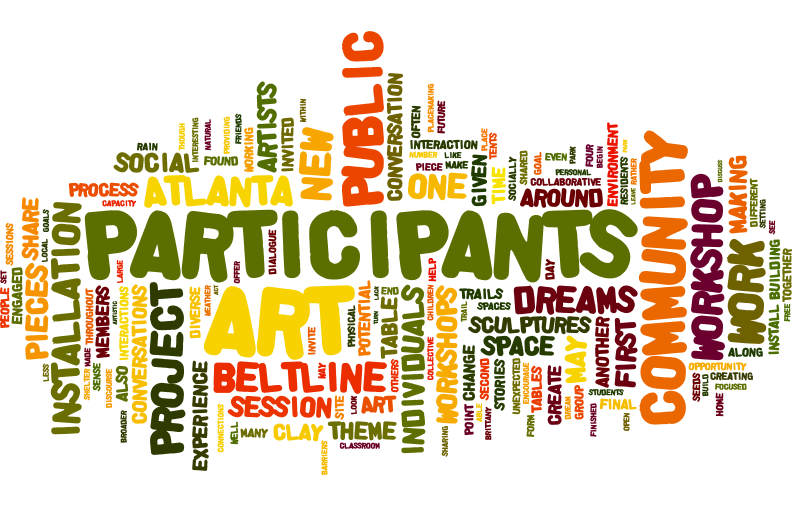Conversations in clay: Engaging community through a socially engaged public art project
Keywords:
Creative Placemaking, Public Art, Socially Engaged Art, Conversation, Community, Clay, ParticipationAbstract
Throughout the course of a given day individuals may weave in and out of shared spaces, passing one another on the trails of a public park or across the stones of a city square, often anonymously, perhaps with a fleeting smile or nod. Creative placemaking, the practice of creating venues that enable community members to express their relationships with one another as well as the physical environment (Webb, 2014), offers a chance to re-envision the community-building capacity of such public spaces. In this paper I describe the process of designing and facilitating a socially engaged public art project for Art on the Atlanta Beltline, a temporary, annual public art festival in Atlanta, Georgia. Conceived as both an art installation and a site for informal art education, this project illustrates the potential for art making in public spaces to invite conversation and encourage empathic interaction between diverse community members.
References
Art on the Atlanta Beltline. (2015, September 23). Retrieved from http://art.beltline.org/.
Barrett, T. (2010). Aesthetics, conversations, and social change. In T.Costantino & B.White (Eds.), Essays on aesthetic education for the 21st Century (pp.123-142). The Netherlands: Sense Publishers.
Barret, T. (2013). Writing towards empathy. In T.Costantino & B.White (Eds.), Aesthetics, empathy and education (pp.29-39). New York: Peter Lang Publishing.
Biesta, G. (2012). Becoming public: Public pedagogy, citizenship and the public sphere. Social & Cultural Geography, 13(7), 683-697.
Bourriaud, N. (2002). Relational aesthetics. France: Les presses du reel.
Carroll, N. (2004). Art and human nature. Journal of Aesthetics & Art Criticism, 62(2), 95-107. doi:10.1111/j.1540-594X.2004.00143.x
Dewey, J. (1938). Experience and education. New York, NY: Kappa Delta Pi.
Eisner, E. W. (2002). The arts and the creation of mind. New Haven, CT: Yale University Press.
Freeman, M., & Vasconcelos, E.S. (2010). Critical social theory: Core tenets, inherent issues. New Directions for Evaluation, (127), 7-19.
Freire, P. (1970). Pedagogy of the Oppressed. New York: Continuum International Publishing Group.
Grodach, C. (2010). Art spaces, public space and the link to community development. Community Development Journal, 45(4), 474-493.
Helguera, P. (2011). Education for socially engaged art. New York, NY: Jorge Pinto Books.
Hetland, L., Winner, E., Veneema, S., & Sheridan ,K. (2007). Studio thinking: the real benefits of visual arts education. New York, NY: Teacher’s College Press.
Kester, G.H. (2004). Conversation pieces: Community and communication in modern art. Berkely: University of California Press.
Richardson, J. (2010). Interventionist art education: Contingent communities, social dialogue, and public collaboration. Studies in art education, 52(1), 18-33
Webb, D. (2014). Placemaking and social equity: Expanding the framework of creative placemaking. Artivate: A Journal of Entrepreneurship in the Arts, 3(1), 35-48.
Wheatley, M. (2002). Turning to one another: Simple conversations to restore hope to the future. San Francisco: Berrett-Koehler.

Downloads
Additional Files
Published
Issue
Section
License
Authors who publish with this journal agree to the following terms:- Authors retain copyright and grant the journal right of first publication with the work simultaneously licensed under a Creative Commons Attribution License that allows others to share the work with an acknowledgement of the work's authorship and initial publication in this journal.
- Authors are able to enter into separate, additional contractual arrangements for the non-exclusive distribution of the journal's published version of the work (e.g., post it to an institutional repository or publish it in a book), with an acknowledgement of its initial publication in this journal.
- Authors are permitted and encouraged to post their work online (e.g., in institutional repositories or on their website) prior to and during the submission process, as it can lead to productive exchanges, as well as earlier and greater citation of published work (See The Effect of Open Access).


